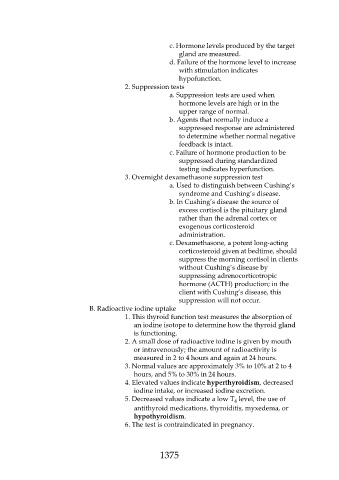Page 1375 - Saunders Comprehensive Review For NCLEX-RN
P. 1375
c. Hormone levels produced by the target
gland are measured.
d. Failure of the hormone level to increase
with stimulation indicates
hypofunction.
2. Suppression tests
a. Suppression tests are used when
hormone levels are high or in the
upper range of normal.
b. Agents that normally induce a
suppressed response are administered
to determine whether normal negative
feedback is intact.
c. Failure of hormone production to be
suppressed during standardized
testing indicates hyperfunction.
3. Overnight dexamethasone suppression test
a. Used to distinguish between Cushing’s
syndrome and Cushing’s disease.
b. In Cushing’s disease the source of
excess cortisol is the pituitary gland
rather than the adrenal cortex or
exogenous corticosteroid
administration.
c. Dexamethasone, a potent long-acting
corticosteroid given at bedtime, should
suppress the morning cortisol in clients
without Cushing’s disease by
suppressing adrenocorticotropic
hormone (ACTH) production; in the
client with Cushing’s disease, this
suppression will not occur.
B. Radioactive iodine uptake
1. This thyroid function test measures the absorption of
an iodine isotope to determine how the thyroid gland
is functioning.
2. A small dose of radioactive iodine is given by mouth
or intravenously; the amount of radioactivity is
measured in 2 to 4 hours and again at 24 hours.
3. Normal values are approximately 3% to 10% at 2 to 4
hours, and 5% to 30% in 24 hours.
4. Elevated values indicate hyperthyroidism, decreased
iodine intake, or increased iodine excretion.
5. Decreased values indicate a low T level, the use of
4
antithyroid medications, thyroiditis, myxedema, or
hypothyroidism.
6. The test is contraindicated in pregnancy.
1375

